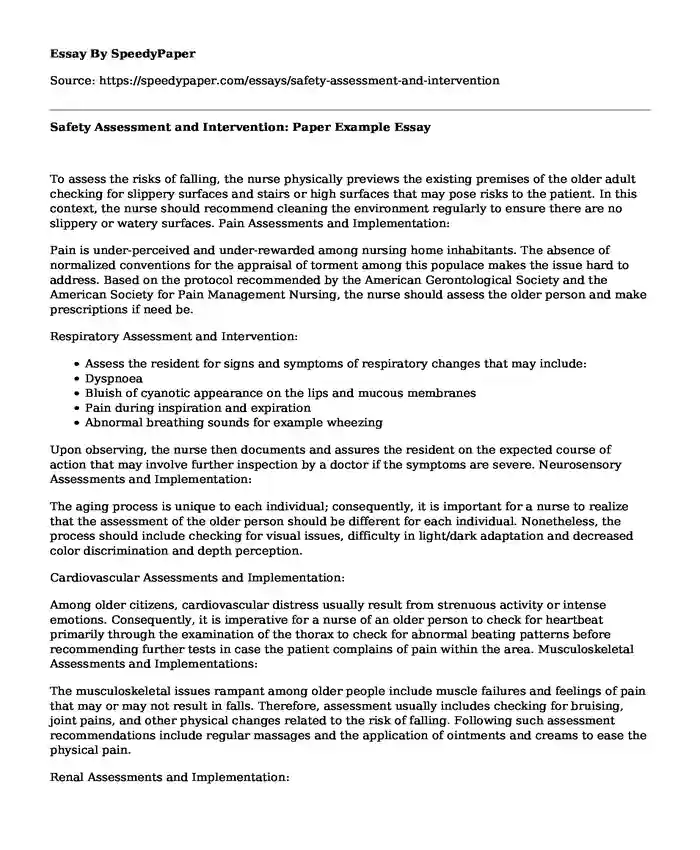
| Type of paper: | Essay |
| Categories: | Healthcare Nursing care Human services |
| Pages: | 3 |
| Wordcount: | 748 words |
To assess the risks of falling, the nurse physically previews the existing premises of the older adult checking for slippery surfaces and stairs or high surfaces that may pose risks to the patient. In this context, the nurse should recommend cleaning the environment regularly to ensure there are no slippery or watery surfaces. Pain Assessments and Implementation:
Pain is under-perceived and under-rewarded among nursing home inhabitants. The absence of normalized conventions for the appraisal of torment among this populace makes the issue hard to address. Based on the protocol recommended by the American Gerontological Society and the American Society for Pain Management Nursing, the nurse should assess the older person and make prescriptions if need be.
Respiratory Assessment and Intervention:
- Assess the resident for signs and symptoms of respiratory changes that may include:
- Dyspnoea
- Bluish of cyanotic appearance on the lips and mucous membranes
- Pain during inspiration and expiration
- Abnormal breathing sounds for example wheezing
Upon observing, the nurse then documents and assures the resident on the expected course of action that may involve further inspection by a doctor if the symptoms are severe. Neurosensory Assessments and Implementation:
The aging process is unique to each individual; consequently, it is important for a nurse to realize that the assessment of the older person should be different for each individual. Nonetheless, the process should include checking for visual issues, difficulty in light/dark adaptation and decreased color discrimination and depth perception.
Cardiovascular Assessments and Implementation:
Among older citizens, cardiovascular distress usually result from strenuous activity or intense emotions. Consequently, it is imperative for a nurse of an older person to check for heartbeat primarily through the examination of the thorax to check for abnormal beating patterns before recommending further tests in case the patient complains of pain within the area. Musculoskeletal Assessments and Implementations:
The musculoskeletal issues rampant among older people include muscle failures and feelings of pain that may or may not result in falls. Therefore, assessment usually includes checking for bruising, joint pains, and other physical changes related to the risk of falling. Following such assessment recommendations include regular massages and the application of ointments and creams to ease the physical pain.
Renal Assessments and Implementation:
Renal illnesses are frequently interminable clutters, acquiring apparent social morbidity. Variables, for example, social disengagement, settlement, and work circumstances, are massively significant. In ESRD, the social situation will apply a substantial impact on the decision of, and capacity to adapt to, a specific dialysis methodology. Business may likewise be influenced one of the objectives of RRT, at every possible opportunity, ought to be to keep a person at work. Personal satisfaction should never be overlooked during all the blood tests. Skin and Integument Assessments and Implementation:
Appraisal of the integumentary framework must be a piece of each paediatric wellbeing evaluation, paying little mind to the purpose behind the human services visit. Adjustment in the trustworthiness of the skin can be the aftereffect of parchedness, hypothermia, contamination, and foundational sickness. Poor individual cleanliness (e.g., messy hair or nails) might be a sign of misery or other emotional wellness issue.
Gastrointestinal Assessment and Implementation:
Assessment of the gastrointestinal system include the analysis of the older adults stool samples in mild cases. Constipation as well as other discomforts can be handled through normal diagnosis and before prescriptions of over the counter drugs to help the discomfort. Endocrine Assessment and Intervention:
Similar to other body processes, the endocrine system reduces in its functionality. Hormones and hormonal imbalances occur resulting in disorders that affect the patient, therefore making it imperative for proper tests that include urine and blood.
Reproductive Assessment and Intervention:
In men, assessment of the patient includes the examination of the prostate gland and for breast disorders. In older women, the evaluation consists of the analysis of the breasts, the womb, and the entire female reproductive system. In such processes, pap smear tests are standard and require a doctor's consultation. Vascular Assessment and Intervention:
As a person ages arteries, the arteries stiffen, resulting in the prevalence of cardiovascular diseases. In such patients, regardless of their immoral lifestyle habits show almost the same symptoms. In such, patients a nurse should check for inflammatory signs of the legs. In more severe cases, symptoms may also include impaired morbidity. Therefore, the significant recommendations that a nurse can make are the bare minimum and will mostly be the instructions provided by the cardiologists or doctors in such an advanced age.
References
Meiner, S. E. (2019). Gerontologic Nursing-E-Book. Elsevier Health Sciences.
Cite this page
Safety Assessment and Intervention: Paper Example. (2023, Aug 24). Retrieved from https://speedypaper.com/essays/safety-assessment-and-intervention
Request Removal
If you are the original author of this essay and no longer wish to have it published on the SpeedyPaper website, please click below to request its removal:
- Free Essay with the Patient's Evaluation Statement
- Free Essay Example - Head Lice
- COVID-19: Balancing the Human-Nature Relationship for a Sustainable Future - Essay Sample
- Congestive Heart Failure Diagnosis- Free Essay Sample
- Free Essay: Data Analysis Framework
- Free Paper Example on Homelessness
- Essay on Tech-driven Healthcare: Improving Quality of Care Through Automation
Popular categories




